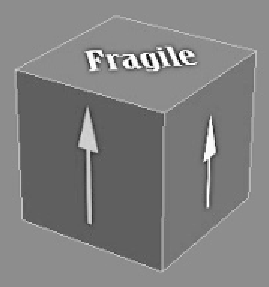Graphics Programs Reference
In-Depth Information
This would allow us to apply a two-dimensional image to this
object from the top down. For example, if we made an image
that had all the information to make this box look like it was
cardboard with “Fragile” and “This End Up” on the sides, we
could now apply it as a flat image on the broken-down box and
it would look correct. However, we'd have to fold it back up if
we wanted it to be that solid box once more.
Figure 17-4: The quick texture
Figure 17-5: The folded box with
a simple texture applied
This is the best way to explain how a two-dimensional image
can be applied to a three-dimensional object and look as if it
were painted directly onto the object. The program needs to
know where to put all those pixels stored in your image map.
You've also just learned the extremely old and dirty
method to unwrapping your objects! Fortunately, after Unwrap
UVW came along we no longer had to rip up our models and
put them back together. Be thankful because this was a very
annoying and time-consuming process! Even using the new
methods it's going to take some getting used to though. Mak-
ing your brain think about unwrapping complex organic shapes
is an interesting process.














